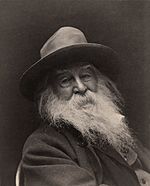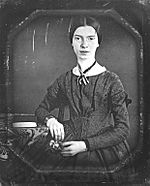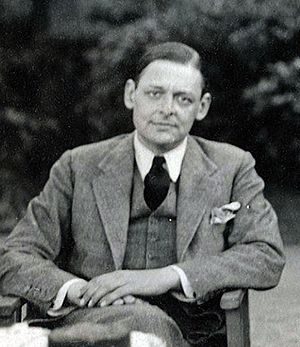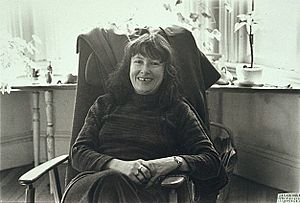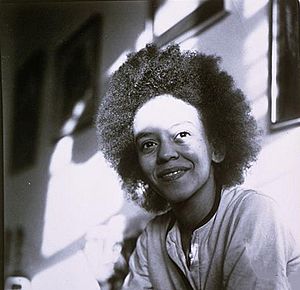Poetry of the United States facts for kids
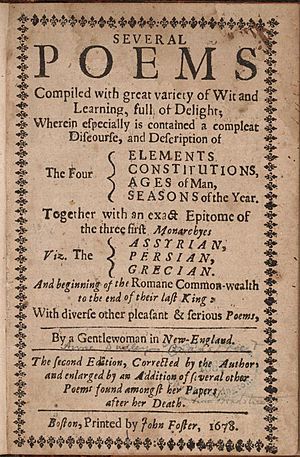
American poetry is the poetry written in the United States. It started in the 1600s when English colonists in America began writing poems. At first, their poems sounded a lot like the English poems of that time. They used similar styles, words, and topics. However, by the 1800s, American poetry started to develop its own special voice and style.
Later in the 1800s, poets like Walt Whitman became very popular, even in other countries. American poets then began to lead the way in new and exciting styles of English poetry. In the early 1900s, poets like Ezra Pound and T. S. Eliot were very important. T.S. Eliot even won the Nobel Prize in Literature in 1948. But it's important to remember that many African American and women poets were also writing and being read widely during this time. Today, scholars are paying more attention to poetry by women, African Americans, and other groups. Louise Glück is a modern American poet who won the Nobel Prize in Literature.
Contents
Poetry in the Colonies
As England started exploring America more after the 1490s, some English explorers wrote poems about the "New World." One of the first important American poets was Anne Bradstreet (1612–1672). She was one of the first known women poets to write in English. Her book, "The Tenth Muse," was printed in London in 1650.
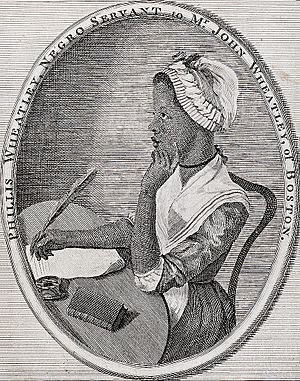
Anne Bradstreet wrote about religious and political topics. She also wrote lovely poems about her home, family, and her love for her husband. Many of these personal poems were not published until much later.
Another early poet was Edward Taylor (1645–1729). He wrote poems that showed the strong beliefs of the Puritans. These poems often used a complex style. For a long time, most poetry in the colonies focused on Puritan ideas.
A very special American poet from this time was Phillis Wheatley. She was an enslaved person whose book, "Poems on Various Subjects, Religious and Moral," was published in 1773. She became one of the most famous poets of her time in the colonies. Her poems often explored religious and classical ideas.
In the 1700s, poets started writing more about America itself. Philip Freneau (1752–1832) is a good example. He wrote about Native Americans in a way that showed he understood them. This was unusual for his time. However, much of the poetry from this period still used older English styles, even though new styles were emerging in England.
Overall, poetry in the American colonies grew much like the colonies themselves. Early poems focused on keeping Puritan ideas strong. As the colonists became more confident, their poems started to show their desire for independence. But the way they wrote their poems stayed quite traditional.
Poetry After Independence
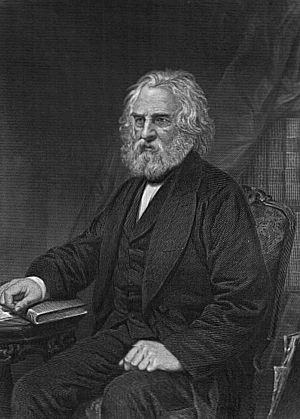
The first important poet of the independent United States was William Cullen Bryant (1794–1878). He wrote beautiful poems about the vast prairies and forests of America. But the first American poet to become famous around the world was Henry Wadsworth Longfellow (1807–1882). He was almost as popular as the famous English poet Alfred, Lord Tennyson.
Longfellow, along with William Cullen Bryant, John Greenleaf Whittier, James Russell Lowell, and Oliver Wendell Holmes, Sr., formed a group called the Fireside Poets. They were from New England in the 1800s. They were called "Fireside Poets" because their poems were so popular that families would gather around the fire to read and memorize them. Their poems often focused on home life, American stories, and politics.
Other important poets from the early and mid-1800s include Ralph Waldo Emerson (1803–1882), Edgar Allan Poe (1809–1849), and Henry David Thoreau (1817–1862). All these writers wanted to find a unique American voice in their poetry, different from British poets. They used the landscapes and traditions of their own country as inspiration.
One famous example is Longfellow's The Song of Hiawatha. This poem used Native American stories. Longfellow copied the rhythm of a Finnish epic poem to avoid using British styles. The poem was very popular, but it didn't become a model for future American poets.
Over time, the ideas of transcendentalism became more important in American poetry. This was a unique American way of thinking that came from English Romanticism. Emerson and Thoreau were key figures in this movement.
Edgar Allan Poe was a very different poet. He wrote about dark and mysterious themes. His poems, like "The Raven," became famous across Europe and influenced many writers, especially in France.
Whitman and Dickinson
The two poets who truly created a unique American style of English poetry were Walt Whitman (1819–1892) and Emily Dickinson (1830–1886). They seemed very different. Whitman wrote long lines, inspired by the Bible, and included everyone in his poems. Dickinson wrote short, focused lines and stanzas, like hymns.
What connects them is their amazing originality and their link to Emerson's ideas. These two poets started two main American poetry styles: Whitman's free verse and direct feelings, and Dickinson's mysterious and ironic style. Both of these styles greatly influenced American poetry in the 1900s.
Other poets like Robert Frost (1874–1963) also played a big role. Frost used strict poetic forms but wrote in a very American way. He brought new life to poems about rural life and created important works. But it was Whitman and Dickinson who truly showed the way for a new, unique American poetry that was less tied to English traditions.
Modern Poetry and Beyond
In the 1900s, American poetry, influenced by French poetry, helped shape Modernist poetry in English. Ezra Pound (1885–1972) and T. S. Eliot (1888–1965) were leaders. They rejected old poetic forms and Victorian language. They made American poetry more complex and focused on new techniques like breaking things into pieces, using hints, and mixing different ideas. Pound also brought influences from Chinese and Japanese poetry into American writing.
Many other poets made important contributions during this time, including Gertrude Stein (1874–1946), Wallace Stevens (1879–1955), William Carlos Williams (1883–1963), and Marianne Moore (1887–1972). Stevens helped bring back philosophical poems. Williams was important because he blended everyday American English with free verse rhythms. E. E. Cummings (1894–1962) is known for his playful use of words and his childlike view of the world.
Not all poets of this era were part of the "high modernism" movement. Some were linked to the New Criticism, like John Crowe Ransom (1888–1974). Other poets, like Archibald MacLeish (1892–1982), tried modernist ideas but also liked traditional writing.
Also, many African American poets of the Harlem Renaissance were writing important works. These included Langston Hughes (1902–1967), Countee Cullen (1903–1946), and Claude McKay (1889–1948). Their work often explored themes of race and identity.
In the 1930s, the Objectivist poets continued the modernist style. They included Louis Zukofsky (1904–1978) and George Oppen (1908–1984). Many of these poets came from immigrant families, which added new experiences and language to American poetry.
After World War II
After World War II, a new group of poets appeared. Many were influenced by Wallace Stevens. Poets like Karl Shapiro (1913–2000) and Randall Jarrell (1914–1965) wrote poems based on their experiences in the war. These poets often used traditional verse forms.
After the war, many new poetry styles and groups emerged. John Berryman (1914–1972) and Robert Lowell (1917–1977) led the Confessional movement. This style focused on exploring the poets' own personal experiences and feelings. Later poets like Sylvia Plath (1932–1963) and Anne Sexton (1928–1974) were greatly influenced by this movement.
In contrast, the Beat poets were very raw and open. They included figures like Jack Kerouac (1922–1969) and Allen Ginsberg (1926–1997). The Beats pushed the boundaries of American language, using everyday speech in their poems. They reflected the open and searching society of the 1950s and 1960s.
Around the same time, the Black Mountain poets, led by Charles Olson (1910–1970), worked at Black Mountain College. They explored "open form" poetry, which meant not sticking to traditional rules. Key poets included Robert Creeley (1926–2005) and Denise Levertov (1923–1997). Their ideas influenced many other poets.
The Beats and some Black Mountain poets helped create the San Francisco Renaissance. This was a time when San Francisco became a center for experimental poetry. Poets like Charles Bukowski (1920–1994) and Jack Spicer (1925–1965) combined everyday language with new poetic experiments.
On the East Coast, the New York School emerged. This group, including John Ashbery (1927-2017) and Frank O'Hara (1926–1966), wrote poems about daily life using everyday language. Their poetry was often clever and elegant. John Ashbery is seen by many as one of the most important American poets since World War II.
American Poetry Today
The last 40 years of American poetry have seen many new groups and trends. The 1970s brought a renewed interest in surrealism, with poets like Andrei Codrescu (born 1946). Performance poetry also grew, coming from the Beat movement and becoming a serious way to share poems. This included a rise in poetry by African Americans, such as Gwendolyn Brooks (1917–2000), Maya Angelou (1928–2014), and Nikki Giovanni (born 1943).
Another group, the Language poets, continued the Modernist traditions. Their poems are often fragmented and sometimes use unusual grammar. They can be abstract, lyrical, or very funny. Many women poets are part of this group, reflecting a growing focus on poetry by women. Important women writers include Adrienne Rich (1929–2012) and Amy Gerstler (born 1956).
While traditional poetry forms were less popular for a while, they have seen a comeback. This is sometimes called New Formalism. Poets like Molly Peacock and Dana Gioia are part of this movement, bringing back rhyme and fixed meters.
Haiku, a short Japanese poetry form, has also become popular in America. Early poets like Ezra Pound were influenced by it. Later, poets like Jack Kerouac and Richard Wright wrote many original haiku. Today, many American poets write haiku, often focusing on nature and the environment.
In recent years, the spoken word tradition of Beat poetry has seen a revival through poetry slams. These are competitions where poets perform their work for an audience. Poetry slams encourage poems that are current, thought-provoking, and easy to understand. They have opened doors for many new writers and performers.
Poetry has also found a new home on the internet, with many online journals, blogs, and websites. This has made it easier for new poets to share their work.
Some poets, like Robert Peters and Nobel Laureate Louise Glück, have unique voices that don't fit easily into any one movement. Louise Glück teaches at Yale University, showing how poetry has become more connected to universities.
Robert Pinsky is a very special figure in American poetry. He was the poet laureate of the United States for three terms, which is a rare honor. His "Favorite Poem Project" invites everyone to share their favorite poems and explain why they love them.
With growing awareness of the environment, many poets are now writing about nature and sustainability. This "ecopoetics" movement builds on the work of earlier poets like Henry David Thoreau and Walt Whitman.
The growth of creative writing programs in universities means that many poets can now make a living as teachers. This has made poetry more professional. Since major publishers often don't publish much poetry, universities and small independent journals have become important places for new poetry to be found.
See also
 In Spanish: Poesía de Estados Unidos para niños
In Spanish: Poesía de Estados Unidos para niños
- Academy of American Poets
- Biker Poetry
- Chicano poetry
- Cowboy poetry
- Haiku in English
- List of national poetries
- List of poets from the United States
- Nuyorican Poetry
- Proletarian poetry


